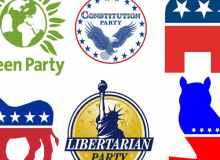
It’s possible to see how the parties overlap by mapping survey results to our six-party mix. Moreover, a less hyperpartisan Congress will also most likely be less gridlocked and more productive, enabling it to reclaim a more central role in our national politics, lowering the stakes of presidential elections and potentially lowering the stakes for Supreme Court nominations in a new era of reduced partisanship. However, with partisan loyalties less fixed, more voters would judge candidates on the content of their ideas and character rather than the D or R next to their names. Roughly 27 of BuzzFeeds audience is considered to have mixed or center-aligned political values (compared with 36 of all respondents to the survey). Absent reform to the Electoral College, presidential elections would still probably come down to two major candidates. The Senate would most likely become a much more free-wheeling institution, as it was in the past. Multiparty democracy would facilitate the shifting alliances and bargaining that are essential in democracy but have largely disappeared in today’s zero-sum conflict. If more parties emerged, coalitions across parties would form to elect a speaker and organize committee assignments - just as coalitions form in multiparty legislatures around the world. Legislation introduced in the current Congress, the Fair Representation Act, would require use of multimember districts with ranked-choice voting in most states’ House selections as well as elections for the Senate. So more than one party could represent a district in proportion to their popularity within that large district - just as they do in most advanced democracies. This approach features districts much larger than our current tiny congressional ones - and each elects more than one person, at once, to represent the region. We get to such a system through proportional multimember districts.

Until American politics nationalized in the 1980s and 1990s around divisive culture-war issues, they operated more independently within the two major political parties. These six parties reflect the underlying factions - and divides - within the Democratic and Republican parties.

They will find a home in either the New Liberal Party or the Growth and Opportunity Party. Many readers who consider themselves centrist might also think of themselves as socially liberal/fiscally moderate or socially moderate/fiscally conservative. That is because there are very few voters in the middle across all issues. Each party represents a different portion of the electorate, not only ideologically but also by economic class and political engagement.


 0 kommentar(er)
0 kommentar(er)
